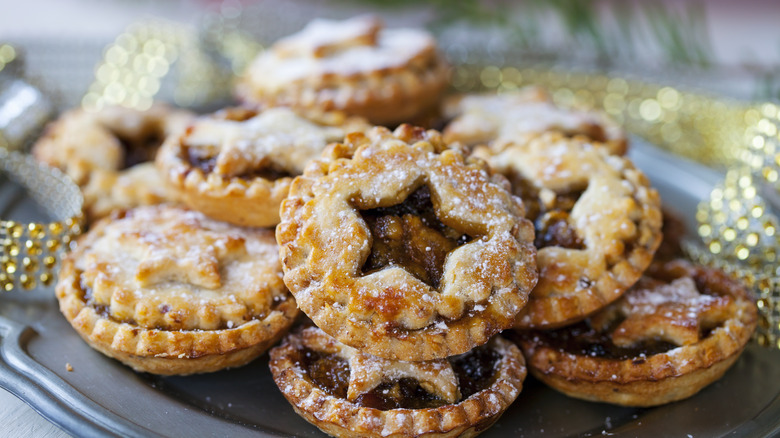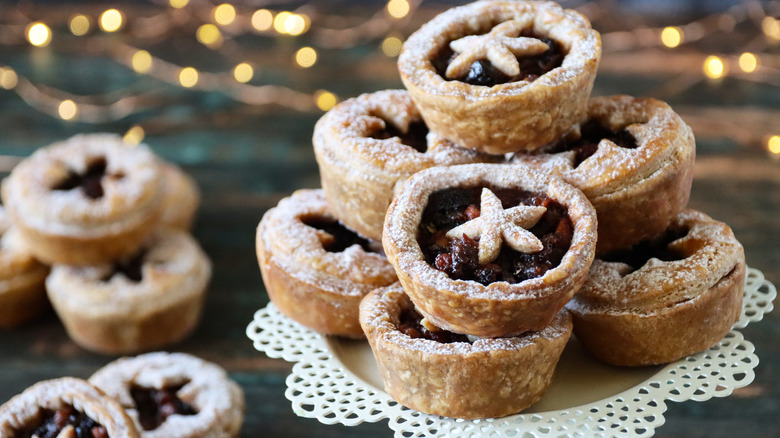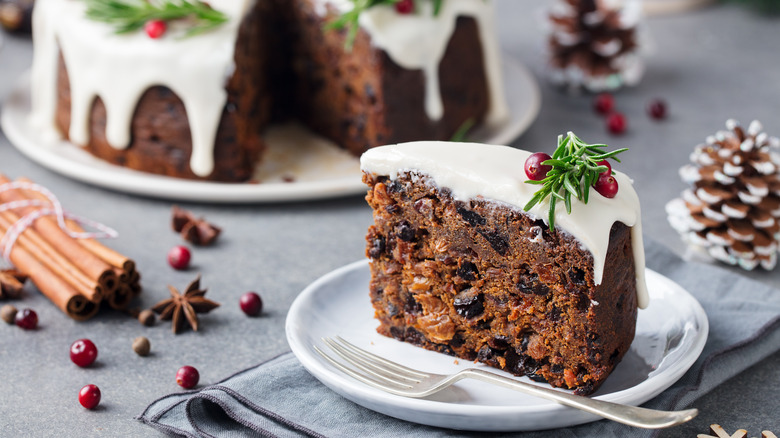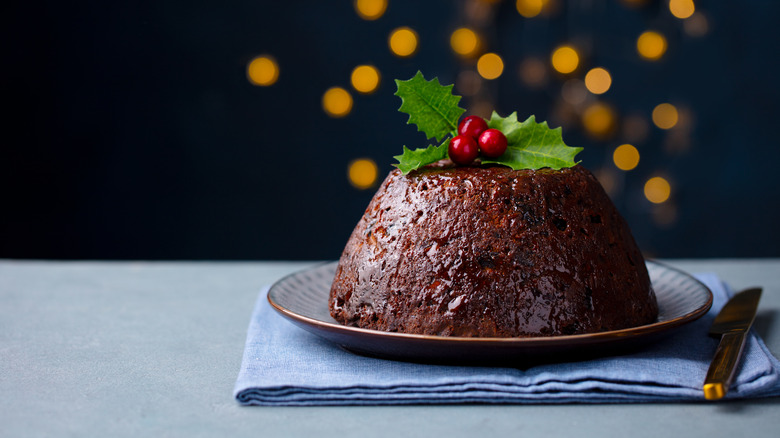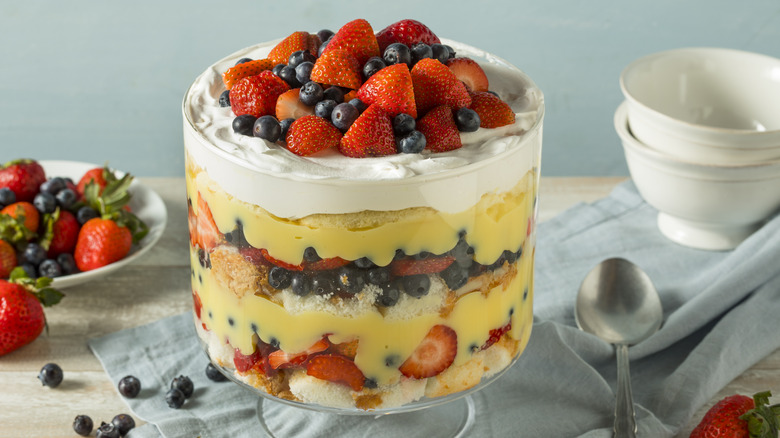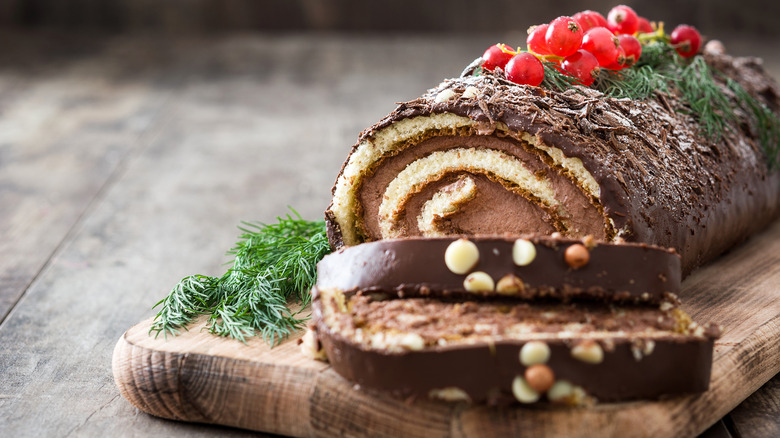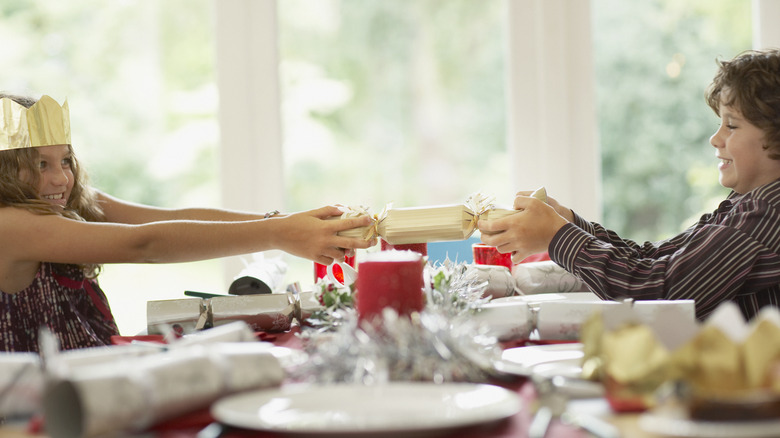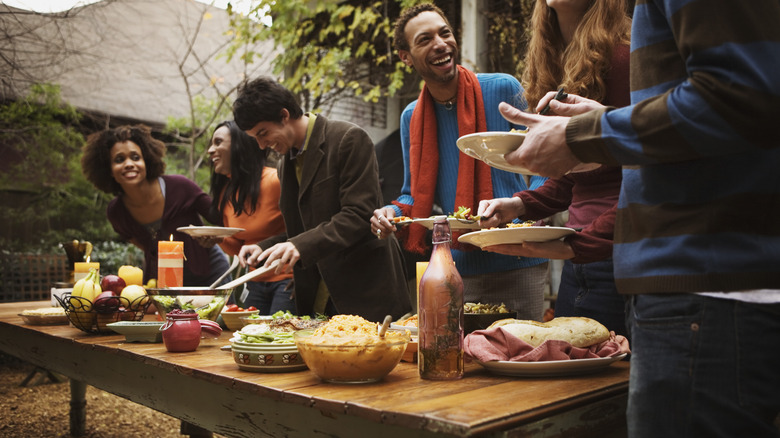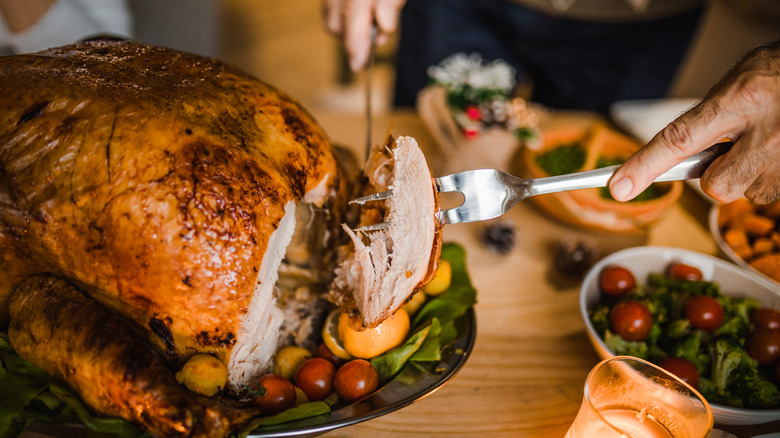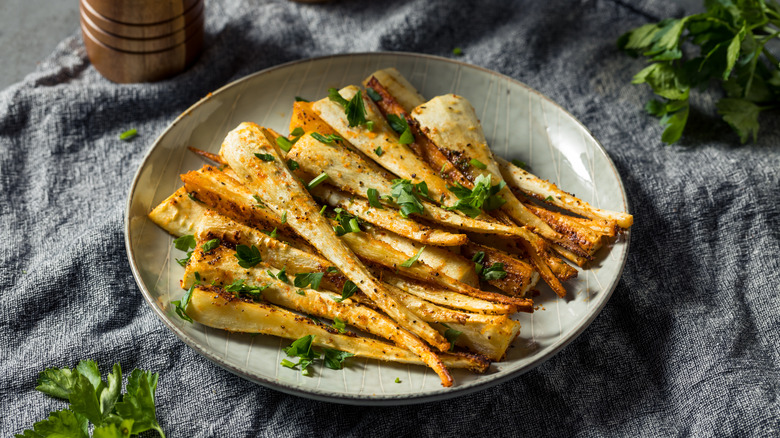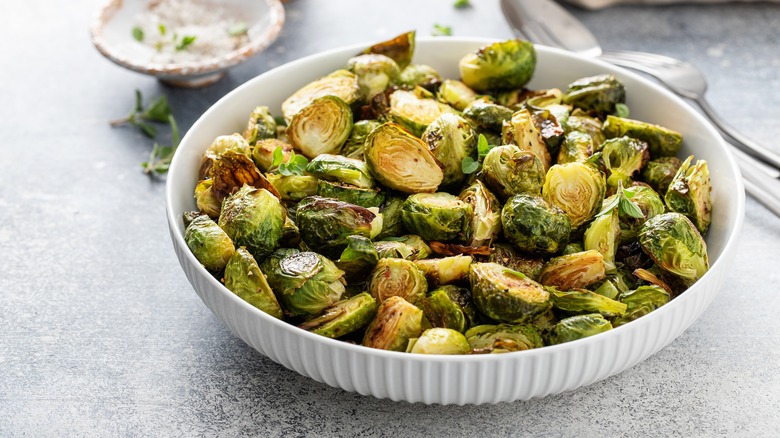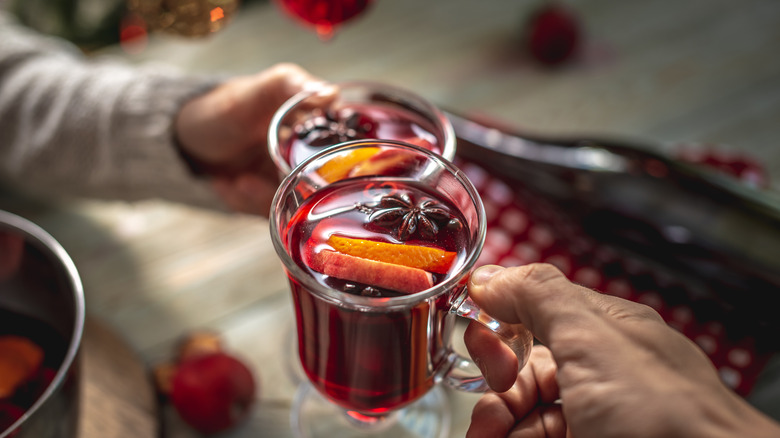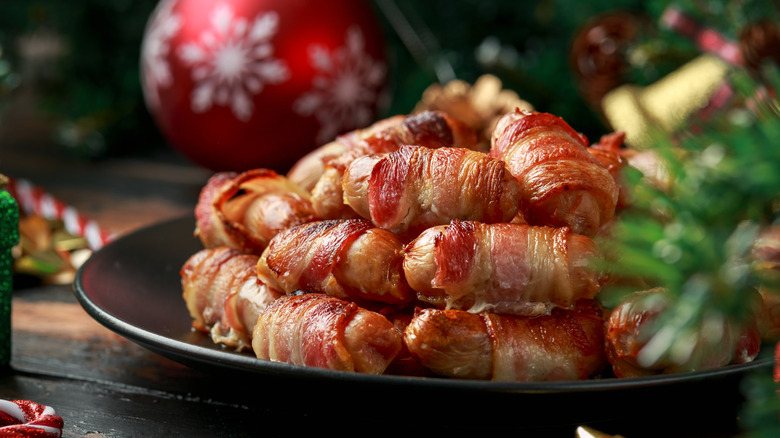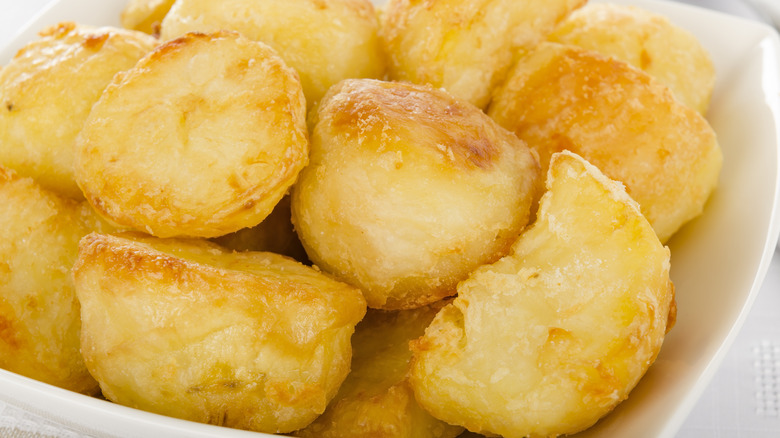15 British Food Traditions Around Christmas
Holiday festivities are officially in full swing, with parties, presents, winter concerts, and lights aglow. It's a busy time of year that involves festivals, holidays, and celebrations from many cultures and communities, including Christmas, Hanukkah, Diwali, and Kwanza. There's certainly no shortage of twinkling lights, gestures of generosity, and wishes for peace. Such lights become beacons of encouragement, helpful for those in the Northern Hemisphere whose daylight hours keep shrinking. For those living in the United Kingdom, night has extended itself from 4 p.m. until 7 a.m., making it all the more necessary to warm and uplift ourselves and our spirits by the glow of the menorah, candle, or Christmas tree.
Christmas in the U.K., though still containing some similar features to celebrations in the United States and elsewhere, also comes with its specific traditions, foods, and rituals. Their nuance, ritual, and sense of history act as a secret sauce, making each a little more delicious. As someone who has come to understand the ins and outs of British Christmas food traditions through years of experience, I can say each is uniquely endearing in its own right. Here are just some of the landmark foods, flavors, and features of Christmas you can expect to find across Great Britain.
Mince pies
In the U.K., it seems the customary seasonal norm for folks to declare their first mince pie of the season publicly. Come mid-November, mince pies hit the grocery store shelves across England, Scotland, Northern Ireland, and Wales, allowing many people to start early with their festive eating. It's not a subtle love affair; Brits spend upwards of 126 million dollars a year on the tiny pies.
Most mince pies are a three-to-four-bite treat; many shop-bought renditions sit in an individual foil casing, looking like a miniature version of the baked good. Do not be fooled by the word 'mince' in the title; these sweet pies have moved past their historical Middle Ages tradition and no longer involve ground meat. They can, however, be made with suet pastry, made either from beef or vegetarian fats or butter.
When it comes to mince pies, the more the merrier. You can shop around to find your favorite and make your own mince pies. The smell of the rich pastry and filling, made with dried fruits paired with generous helpings of warming cinnamon, ginger, clove, and nutmeg, will make your whole house smell like Christmas.
Christmas cake
Unlike the subpar, slightly misunderstood, stateside reputation of fruit cake, Brits hold their love of the dish close to their hearts and plates. They've even marked the time of year when folks nationwide begin to prep their Christmas cakes, known lovingly as 'Stir-up Sunday.' It's a centuries-old British food tradition that takes place the last Sunday before Advent begins. Made of dried fruits, spices, and the all-important brandy (optional), the cakes then have time to rest, set, and (if you're using it) be fed more alcohol before serving on Christmas Day.
Though now part of the national Christmas repertoire, the modern-day Christmas cake, heavy and often topped with a layer of marzipan following a layer of fondant icing perfect for decorating, didn't always take this form. For those humming the tune "We Wish You a Merry Christmas," the figgy pudding the song speaks of closely resembles the bake's original form, designed to help tide over those who were more religious and would spend the day fasting. It has since morphed, first into Christmas pudding, and then onto the cake, bought, sold, and stirred up in frenzied crowds across the nation.
Christmas pudding
The term 'pudding' has come to mean several things within British culture — none involving the creamy, box-made Jell-O label. Primarily, pudding is used in reference to dessert, as in, "I'll have the cheesecake for my pudding, please." However, when referencing British culinary traditions, especially those around Christmas, the term pudding refers to steamed pudding, often consisting of suet, dried fruits, and brandy. In recent years, more alternative puddings have made their way to the forefront, including steamed carrots, chocolate, and cherry versions. Alongside the Christmas cake, Christmas puddings are also referenced during the ritual Stir up Sunday.
Depending on your family's ability to afford meat, sugar, or spices, a mixture of some or all has been added to the dish over time. However, puddings were traditionally a meal for the lower class, made from grains and water or milk clotted with breadcrumbs. Sometime around the 17th century, plum pudding grew out of this melange of stodgy ingredients, which by the 19th century became more closely affiliated with the boiled cake of dried fruits and spices, eventually topped by brandy butter beginning in the earlier part of the 20th century.
Trifle
For those looking to assemble rather than bake, per se, trifle is a popular item. It is often present at Christmas and throughout the year. A trifle consisting of lemon Swiss roll and amaretti was crowned as the commemorating dish of the late Queen's Platinum Jubilee. Needless to say, trifles are a beloved British food tradition, whether on Christmas or otherwise.
One of the best characteristics of this dessert is the play on textures and the highly customizable list of ingredients, from fruit-based creation to chocolaty black forest recipes. Swiss roll, custard, fruit, chocolate, berries, cream, jam, and jelly (or Jell-O across the pond) are all viable choices. If only adults are partaking in the layered and luscious dessert, a good helping of sherry can also be poured over the sponge of the jelly roll to create a sweet, boozy heaven. When eaten with stewed fruits like peaches and pears, a silky custard, or topped with fresh whipped cream and dark chocolate shavings, it is the ultimate do-ahead Christmas dessert and crowd pleaser. It is definitely a personal favorite on this list.
Yule Log
Also known as a Bûche de Noël, a Yule log is a classic in the lineup of desserts likely to be featured during the festive period around Christmastime in the U.K. It's a dessert that requires a deft hand and a good amount of confidence to pull off. However, you will feel like a total rock star once you get the hang of it. Chocolate lovers, this one is for you.
Who could ever look down at a classic Yule log, consisting of a chocolate sponge and a layer of cream, gently rolled up into a log, then layered or drizzled with melted chocolate for bark? The tradition of burning a Yule log goes back to Scandinavian or Germanic ceremonies; before medieval times, it was customarily lit from the remains of the previous year's log and burnt during a festival to honor the winter solstice. Burning the log is optional as the traditions have changed and adapted over the years. However, the chocolate version is a lovely and surprisingly light way to end the Christmas feast compared to some of the heartier desserts on this list. Some rather decadent and over-the-top versions are available to purchase, too, for those who live by the motto "more is more," especially at Christmas.
Christmas crackers
Not to be confused with the crispy bread served with a cheese board, Christmas crackers are not quite a food but a Christmas tradition at the dinner table. The tube-shaped parcel, often containing a prize, a joke, and a paper crown, is bookended with excess paper on each end for pulling. The tradition, which involved two guests pulling at each end in hopes of breaking off the prize, much like a wishbone, has since made its way to the U.S., though it has been part of the holiday traditions in the U.K. for over 150 years.
The Christmas cracker, as Brits know it, was first invented in London by an East End confectioner and baker named Tom Smith. The shape was inspired by the bonbons of Paris. When pulled simultaneously by two dinner guests, the friction results in an audible pop and cracking sound, devised by a second source of inspiration: the crack of a burning log. Christmas crackers are a little bit of fun. They're a great ice breaker if sitting with guests you don't know very well, encouraging folks not to take themselves too seriously by wearing the colorful paper crowns tucked inside (provided it fits your head).
Boxing Day feasts/leftovers
There is something to be said for the British dedication to leftovers and the traditions around the day after Christmas, known as Boxing Day. The holiday was created as an opportunity for household staff and the laboring class, subject to working on Christmas, to enjoy a day of food and family. Often, gifts and donations, including leftovers from Christmas meals, would be redistributed, with collections of gifts collected in boxes from various aristocrats and the upper echelons of society.
Today, Boxing Day can be a bit of a relief for everyone (unless you're working retail and subject to the start of post-Christmas sales). It can be a chance to get together to eat without gift exchanges, making good on the Christmas leftovers by turning them into the ultimate sandwich, or more relaxed eating and socializing in general, including more buffet-style meals if hosting guests, or casseroles and one-pot cooking for ease and comfort.
Christmas turkey (or goose)
With a few exceptions, tweaks, and twists, a traditional Christmas dinner in the U.K. can look and taste an awful lot like American Thanksgiving, with several mainstay ingredients making their annual appearances. Such features include stuffing, seasonal root vegetables, potatoes, and the proverbial centerpiece: turkey. As Thanksgiving isn't celebrated across the pond, Brits aren't yet tired of it by the time Christmas rolls around.
Unlike in America, turkey is not native to the U.K., making it a slightly head-scratching choice that has been eaten as a part of Christmas tradition for hundreds of years. Instead, the bird was brought from America by way of 16th-century Spanish conquistadors. Eventually, it was served to King Henry VIII, thus qualifying itself as a luxury item fit for royalty, and by the 19th century (and a host of turkey breeding attempts), the practice trickled down to the British public.
Christmas goose is also a popular, though a more expensive, alternative to turkey, stemming from Queen Elizabeth I in the late 16th century. Goose is also an auspicious tradition and a sign of good luck and prosperity, served during the feast of Saint Michael and All Angels, known as Michaelmas, in early autumn.
Parsnips
Christmas dinner calls for a round-up of all the winter vegetables the U.K. has on offer. At this time of year, the list isn't exhaustive and is mainly consistent with root vegetables, potatoes, and heartier greens like cabbage and Brussels sprouts. Parsnips are one such vegetable, pulled from the frozen ground to be peeled, roasted, and slathered in butter and honey.
These pale, gently sweet, earthy vegetables have a carrot-like shape and can sometimes be underappreciated on the table, upstaged by bacon-wrapped sausages, roasted potatoes, and the roast turkey centerpiece. But make no mistake, for many British households, the Christmas feast is incomplete without the subtle presence of the humble parsnip.
Parsnips are a wonderfully hearty, fuss-free, adaptable vegetable that needs little finesse to come out well. Peel, cut, coat in whatever fat you like (butter or oil are both excellent), and tuck a roasting pan with parsnips into the oven towards the final hour of the turkey's cooking. You can also add a scattering of Parmesan to your parsnips for an extra savory touch.
Brussels sprouts
There's an unspoken rule in some households that suggests anyone who sits down to Christmas dinner (or lunch, depending on when you eat) must consume at least one Brussels sprout to commemorate the season. Or, at the very least, put one on your plate, even if it remains there. Like cabbage, sprouts are one of the few green things to come out of the ground at this time of year, so it makes sense that they've been incorporated into the Christmas meal. They're such a British mainstay in the annual Christmas meal that the British are known for eating more sprouts than any other European country; we're not quite sure if this counts as bragging rights.
Originally from Rome, having migrated to Belgium, where they were first officially recorded (hence their name), Brussels sprouts are part of the hearty Brassicaceae family. Brussels sprouts have an underlying sweetness to them that goes incredibly well when roasted with bacon and chestnuts or simply steamed and served with butter and herbs. Christmas feasts do well with a bit of green on the table, and these guys are a seasonal solution to do just that.
Mulled wine
There's nothing quite like a dark, cold evening paired with a cup or mug of mulled wine. Associated with Christmas markets and parties, mulled wine splits the difference between offering guests a hot drink and an alcoholic beverage by doing both. Its smell is a permanent fixture around the holiday season in the U.K. and is available at most outdoor events, markets, light displays, parties, and food festivals. It also happens to pair perfectly with a mince pie, increasing its popularity.
Though you can buy the pre-made version, which is available in most grocery stores and wine shops, it's also nice to make your own mulled wine, especially if you're the one hosting Christmas this year. Its aroma, heavy with whole spices like cinnamon, clove, vanilla, and star anise, and rich from red wine, practically permeates with feelings of Christmas and good cheer. It can also inspire feelings of nostalgia and trips to the past to Germany's Christmas markets, a popular tradition in the U.K.
Pigs in blankets (bacon-wrapped sausages)
This festive favorite has confused Americans, who know pigs in a blanket to mean hot dogs wrapped in puff pastry — no hot dogs or pastry in this meaty British mainstay. Instead, pigs in blankets in the U.K. means streaky bacon-wrapped sausages. If you've made this mistake before, you're far from the only one. Even New York Magazine once confused the two, mistakingly calling Tom Hank's Super Bowl dish a tribute to the British' pigs in blankets' instead of sausage rolls — the correct U.K. terminology for a hot dog or sausage wrapped in puff pastry.
When it comes to pigs in blankets, pork and meat eaters tend to consider this the best part of the meal — you can't make too many. Thankfully, they're also easy to make, simply by wrapping a piece of streaky bacon tightly around the sausage, often chipolata. Then, lay sausages on a baking tray and put them into a hot oven until the bacon is cooked and caramelized. They are smoky, salty, and a bit sweet, especially if using maple-glazed bacon, and are always a welcome treat at the Christmas table.
Roast potatoes
It's always interesting to observe which potato cooking method is considered to be the most appropriate choice and in what situation. The baked or jacket potato tends to reign supreme at a steak house. At Thanksgiving, we can probably all agree that mashed potatoes are the suggestion of choice. With a burger, it's got to be French fries. And, you better serve roast potatoes at a British Christmas meal unless you want to listen to your father-in-law mourning the loss of his favorite side dish all night. The thing is, he's not wrong. Roast potatoes are, unequivocally, one of the very best parts of British food traditions around Christmas time.
There is something exceptional about the British roast potato. Its crispy, crunchy golden layer on the outside contains a fluffy center perfect for soaking up gravy; it is truly a work of art. Even King Charles has opinions about the best method for roasted potatoes, as does everyone around the country with a love for a Sunday roast.
Watching the monarch's speech
Though the upkeep of this particular tradition may pertain more to the older generations, it's hard to imagine a Christmas Day celebration in the U.K. without thinking of the H.M.'s Christmas speech, delivered every year on December 25th at 3 p.m. Depending on when the main meal is served, many families and hosts use this as an invitation for a toast and a drink alongside a snack, either as a precursor or marking the end of the main Christmas Day feast.
The first Christmas Day broadcast speech by a king or queen was delivered by King George V in 1932 and has carried on ever since. Her Majesty Queen Elizabeth was responsible for 69 speeches, only missing one year — 1969 — when she wrote a letter instead. Unlike elected members of parliament, who must refrain from referring to any non-secular practice or reference in their speeches, the monarch takes up the role as head of the Church of England and, therefore, is allowed to mention god. Frequently, the speech reflects the previous year, measured in its delivery, with encouraging themes of peace and family.
Advent calendars and chocolate coins
Lastly, this list would be remiss without the mention of the advent calendar. The advent calendar is the single reason most parents across the U.K. can justify allowing their child to eat chocolate before even brushing their teeth in the morning and then sending their sugar-filled child off to school all December long.
The calendar, and Advent itself, are not solely British traditions but rather used as a marker (and marketing) of the reflective period in the lead-up to the celebration of the birth of Jesus Christ.Still, the sheer amount of advertising and offerings of chocolate coin-filled calendars is enough to call it a British food tradition that has been removed from its religious origins.
Though there are advent calendars for adults, too, containing daily gifts from potato chips to beer to teas, the ones most commonly embraced within British culture are aimed at children. Filled with sweets or toys and set at an affordable price for most, they stoke anticipation and excitement for what's to come at Christmas.
